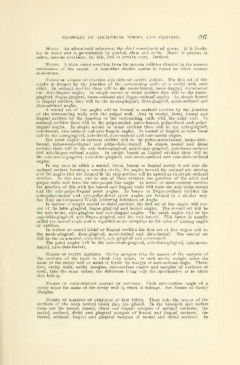Page 555 - My FlipBook
P. 555
GIjOSSAEY of technical terms AJSl) PHKASES. 297
Mucin. An albuminoid substance, the chief constitufint of mucus. It is insolu-
ble in water and is precipitated by alcohol, alum and acids. Mucin is present in
saliva, mucous secretions, the bile, and in certain cysts. Dorland.
Mucus. A thick viscid secretion from the raucous follicles situated in the mucoiis
membranes of the mouth. A somewhat similar mucus is found on other mucous
membranes.
Names of angles of cavities and sets of cavity angles. The first set of line
angles is formed by the junction of tho surrounding walls of a cavity with each
other. In occlusal cavities these will be the mesio-buceal, mesio-lingual, disto-buccal
and distolingual angles. In simple mesial or distal cavities they will be the bucco-
gingival, linguo-gingival, buccoocclusal and liuguoocelusal angles. In simple buccal
or lingual cavities, they will be the mesio-gingival, disto-gingival, mesio-occlusal and
disto-occlusal angles.
A second set of line angles will be formed in occlusal cavities by the junction
of the surrounding walls with the pulpal wall. And in mesial, distal, buccal and
lingual cavities by the junction of the surrounding walls with the axial wall. In
occlusal cavities these will be the pulpo-mesial, pulpo-buccal, pulpo-distal and pulpo-
lingual angles. In simple mesial or distal cavities these will be the axiogingival,
axio-buccal, axio-occlusal and axio-lingual angles. In buccal or lingual cavities these
will be the axio-gingival, axio-distal, axio-occlusal and axio-mesial angles.
The point angles in occlusal cavities will be the pulpo-mesio-buccal, pulpo-disto-
buccal, pulpo-mesio-Ungual and pulpo-disto-lingual. In simple mesial and distal
cavities these will be the axio-bueeo-gingival, axio-linguo-gingival, axio-bucco-occlusal
and axio-linguo-occlusal angles. In simple buccal or lingual cavities these wiU be
the axio-mesio-gingival, axio-disto-gingival, axio-mesio-occlusal and axio-disto-occlusal
angles.
In any case in which a mesial, distal, buccal or lingual cavity is cut into the
occlusal surface forming a complex cavity, the angles toward the occlusal are missing
and the angles that are formed in the step portion will be named as in simple occlusal
cavities. In this case, and in any of these cavities, the junction of the axial and
pulpal walls will form the axio-pulpal line angle. In mesio- or disto-occlusal cavities
the junction of this with the buccal and lingual walls will form the axio-pulpo-buccal
and the axio-pulpo-lingual point angles. In bucco- or linguo-occlusal cavities the
axio-pulpo-mesial and axio-pulpo-distal point angles are formed in a similar way.
See Note on Compound Words following definition of Angle.
In incisor or cuspid mesial or distal cavities, the iirst set of line angles will con-
sist of the labio-gingival, lingiio-gingival and ineisal angles. The second set will be
the axio-labial, axio-gingival and axio-Ungiial angles. The point angles will be the
axio-labio-gingival, axio-linguo-gingival and the axio-incisal. This latter is usually
called the ineisal angle and is regarded as an exception to the rules of naming angles
of cavities.
In incisor or cuspid labial or lingual cavities the first set of line angles will be
the mesio-gingival, disto-gingival, mesio-incisal and disto-incisal. The second set
will be the axio-mesial, axio-distal, axio-gingival and axio-iueisal.
The point angles will be the axio-mesio-gingival, axio-disto-gingival, axio-mesio-
incisal, axio-disto-incisal.
Names op cavity makgins. Cavity margins take the names of the margins of
the surfaces of the teeth in which they occur; or each cavity margin takes the
name of the cavity wall of which it forms the margin or cavo-surface angle. There-
fore, cavity walls, cavity margins, cavo-surface angles and margins of surfaces of
teeth, take the same names, the difference being only the specification as to which
they belong.
Names of cavo-surface angles of cavities. Each cavo-surface angle of a
cavity takes the name of the caWty wall to which it belongs. See Names of Cavity
Margins.
Names of margins of surfaces of the teeth. These take the names of the
surfaces of the teeth toward which they are placed. In the bicuspids and molars
these are the mesial, buccal, distal and lingual margins of occlusal surfaces; the
mesial, occlusal, distal and gingival margins of buccal and lingual surfaces; the
buccal, occlusal, lingual and gingival margins of mesial and distal surfaces. In


